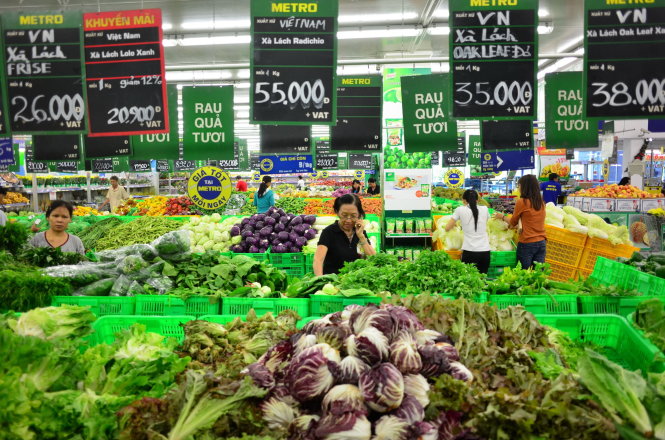TNS Vietnam has released a special report to review 20 years of growth in Vietnam, in celebration of two decades of tracking and providing insight into Vietnamese consumers by the market research firm.
Part of Kantar, the data investment management division of WPP and one of the world's largest consultancy groups, TNS began its operations in Vietnam in 1996.
Over the past two decades, TNS has observed “just how much the Vietnamese market has grown, changed, and developed into one of the world’s most vibrant economies,” it said in a press release on Monday.
20 years of economic growth
Ashish Kanchan, managing director of TNS Vietnam, said the Southeast Asian country is “an incredible growth story.”
In 1996 when TNS Vietnam was founded, the Vietnamese economy was booming, boasting a 9.3 percent growth rate.
The world has since gone through an economic crisis, which was followed by a global slump that dampened growth across markets, but Vietnam “has consistently remained relatively strong,” Kanchan said.
“For the past 20 years Vietnam’s GDP has far exceeded the world average, and the GDP per capita growth proves the strength of the rapidly growing productivity and prosperity of the Vietnamese people,” Kanchan commented.
“The numbers highlight the potential and viability of this rapidly emerging market.”
Over the past 20 years TNS has studied how personal incomes have grown.
Workers in Vietnam’s biggest cities are now earning nearly five times as much on average as they did in 1999, Kanchan said, citing findings from TNS’s VietCycle and Consumer Pulse reports.
In 1999, the goods people most aspired to have were motorbikes, personal computers, and washing machines.
But aspirations have shifted to bigger ticket items such as cars, smart TVs, and air conditioners, as rising incomes have made those items more attainable.
“However, even these new aspirational items are becoming attainable to a growing segment of the population which is borne out in the massive boom in car sales,” Kanchan noted.
“When we look at other past aspirational categories such as travel for leisure, rising incomes have allowed that industry to blossom.”
In the past, travel, even domestic, was out of reach for most consumers, while Vietnamese today are able to travel thanks to increased incomes and the rise of budget airlines to meet consumer needs.
“Even travel by land has become easier with continued investments into the country’s infrastructure making land travel more comfortable and efficient,” Kanchan concluded.
20 years of consumer insight
In its Quarter 2, 2016 Consumer Pulse study, TNS placed Vietnam’s Consumer Confidence Index at the highest-ever 91 points.
The index is based on Vietnamese expectations for the value of the Vietnamese dong, employment, Vietnam’s economy, and personal standards of living, according to the market researcher.
“The high Consumer Confidence Index shows continued positivity in 2016 by Vietnamese consumers but that index has changed over the years,” Kanchan said.
The TNS official underlined that it is important to remember the landscape that existed back in the 1990s.
“The country had recently normalized relations with the United States, the world economy was doing well, and as a result, consumer expectations and outlooks were sky-high,” he elaborated.
Kanchan noted that although consumers are still highly optimistic, they are more reserved in their expectations, as the Consumer Pulse survey shows.
“Vietnamese are realizing that even though the country continues to grow rapidly, improvements to daily life will become more gradual than in the early days,” he added.
Ninety-six percent of Vietnamese expect stability or improvement in their standard of living, while at the same time, expectations for a worse standard of living have declined, leaving the vast majority of Vietnamese holding positive or neutral sentiments, according to the study.
TNS has also tracked how consumers have changed their lifestyles and ways of thinking, and how their interest in entertainment has changed over the last 20 years.
For example, in 1999 TNS found that 78 percent of consumers thought women must focus only on traditional roles, but that number had fallen greatly to 51 percent in the latest Consumer Pulse study.
Similarly, while Internet surfing was nearly non-existent back in the 1990s, it is the most commonly reported activity to relax at home by urban Vietnamese today.
The next 20 years
After observing the Vietnamese consumer’s evolving tastes and habits over the past 20 years, TNS said there are some game-changing trends that are shaping the landscape for brands and consumers in Vietnam.
Three of those trends to watch, according to the market researcher, are the rise of digital, the convince category, and the importance of emotional drivers.
Kanchan concluded that Vietnam has been “an amazing country to watch,” with consumers' overall optimism for the future remaining steady despite changes the nation has made over the years.
“We are eager to see how the rest of the year concludes with our rolling Consumer Pulse studies to be conducted later in 2016, and are looking forward to our next 20 years in Vietnam,” he said.

Like us on Facebook or follow us on Twitter to get the latest news about Vietnam!


























































